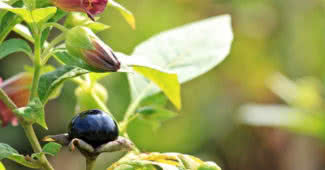If you have adorable pets at home, please be ensure your houseplants are pet friendly. Even your well-behaved pets might chew or consume these indoor plants out of mischief or curiosity. So investigate each plant before you purchase since some are toxic to pets. Consider the following list of top 10 non-toxic indoor plants as per ASPCA that help add greenery to your home, clean your air, and improve your mood while ensuring your lovely pets are safe and sound.
10Purple Waffle Plant
The Purple Waffle Plant is a beautiful, highly ornamental houseplant native to Asia. Its leaves have a rich purple shade with a wrinkled texture, resembling a waffle. The plant thrives in moist and sunny conditions and is perfect for year-round decoration in homes and offices.
It can grow easily indoors and looks great in a container or clay pot that contrasts with the purple leaves. Since the plant is non-toxic, you do not need to worry about your pets getting sick from it. Additionally, the plant can contribute to indoor air quality. Also, it requires frequent watering to maintain moist soil and grow properly.
9Boston Fern
These plants are highly beneficial for dry nostrils or skin since they can act as humidifiers. Pet owners may find its foliage non-toxic to their pets, so there is no need to worry about harm. However, since children and pets may find the plant attractive, always keeping it out of reach is best.
Top 10 Most Deadliest Plants In The World
8Bromeliad
Bromeliads are among the most diverse plants comprising around 3,500 known species. They can thrive with bright light and humidity, making them perfect for those who want low-maintenance plants. No part of the Bromeliad is toxic to pets, and even more, some species of bromeliads are as edible.
According to a study conducted in 2016, it was clear that Bromeliads can break down volatile organic chemicals (VOC), causing dizziness and allergic reactions. Although they are generally safe, cats may experience digestive or distress issues if they consume too much of the plant.
7Moth Orchid
Moth Orchids are beautiful orchid species that come in white, purple, and pink flowers, cultivated for the commercial flower trade. Many pet owners may wonder if the orchids and their pets can coexist perfectly well without causing any danger. However, the ASPCA assures that these orchids are not toxic to pets when they accidentally ingest them. And this characteristic applies to all varieties of moth orchids.
Nevertheless, taking caution when using fertilizers or pesticides on these plants is important, as these substances can threaten your furry friends. If you suspect the pet has consumed plants on which you applied fertilizer, seek immediate veterinary assistance.
6Friendship Plant
The Friendship Plant is a low-maintenance houseplant easily available for interior gardeners to decorate their living space. These plants have ovate leaves growing in opposite pairs. They are non-toxic to pets and don’t have much effect even if they bite the plant’s fuzzy and wavy leaves.
Friendship Plant prefers warm temperatures and humidity and can grow well in terrariums. They can tolerate medium and low light and usually grow at most 12 inches. These fast-growing plants can detoxify your home from dust and airborne toxins. Sometimes, the plant may surprise you with pale pink flowers if you give them proper care.
5Christmas Cactus
The Christmas cactus is a popular houseplant that blooms indoors in the winter and is considered a great gift by interior gardeners. The plant’s most significant characteristic is the bright salmon-to-red flowers that bloom during Christmas. They prefer growing in a shady habitat with high humidity on trees or rocks.
Since not true cacti, they lack the spines found on cacti and hence won’t cause any injury to your pets. The ASPCA lists the Christmas cactus as a non-toxic indoor plant, so neither the cactus nor the flowers are poisonous to pets. However, a large dose may cause vomiting and diarrhea.
4Chinese Money Plant
Occasional misting can help combat dry air caused by central heating. Being non-toxic to pets, you need not worry if your furry friend bites or chews its leaves. This plant also makes an excellent choice, even if you have a young child at home who loves exploring the world using their mouth.
3Gloxinia
But remember, it prefers growing well in low light, so keep it out of bright, direct light. Also, frequent watering and moist soil are perfect during their growing period. Moreover, Gloxinia is a safe, non-toxic option for pet owners who want to add an extra touch of elegance to their home decor.
2Air Plant
Although non-toxic, pets may cause harm to air plants out of curiosity. Cats, in particular, may find air plants appealing because of their voracious appetite for them. So, to keep the plants safe, try arranging air plants in a terrarium with a smaller opening or hang the terrarium suspended at a height that is out of reach of pets.
Related Articles
1African Violet
However, pet owners should note that allergic reactions may occur if pets consume large amounts of African violets. Additionally, avoiding using pesticides or fertilizers during the plant’s growth is important as these may pose a hazard to pets.




